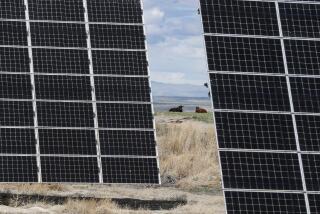China takes lead in clean-power investment
- Share via
Reporting from Washington — China overtook the United States for the first time last year in the race to invest in wind, solar and other sources of clean energy, according to a comprehensive new report that raises questions about American competitiveness in a booming global market.
U.S. clean energy investments hit $18.6 billion last year, a report from the Pew Charitable Trusts said, a little more than half the Chinese total of $34.6 billion. Five years ago, China’s investments in clean energy totaled just $2.5 billion.
The United States also slipped behind 10 other countries, including Canada and Mexico, in clean energy investments as a share of the national economy.
Although part of the U.S. investment decline last year can be attributed to the deep recession, the Pew report pointed to another factor constraining U.S. competitiveness: a lack of national mandates for renewable energy production or a surcharge on greenhouse gas emissions that would make fossil fuels more expensive.
The report warned that the current U.S. approach, in which states make varied efforts and the federal government’s efforts have been sporadic, has produced a “comparatively weak clean energy economy” -- and that the nation risks losing out on economic growth and job creation.
“It’s certainly the case that the countries and areas with higher investment in clean energy will be able to produce more jobs,” said Chris Lafakis, an economist at Moody’s Economy.com, which is working with Pew in tracking the green economy and jobs. Lafakis said investment was the No. 1 factor in green job growth.
Worldwide, the report found clean energy investment more than doubling since 2005. Investment levels have already rebounded from the financial crisis and are projected to grow 25% this year, as nations increasingly seek energy sources that do not emit the heat-trapping gases produced by burning fossil fuels.
The study tallied public and private spending for clean energy equipment and generating capacity as well as venture capital funding of companies involved in green industries and related areas. The figures are derived from a Bloomberg New Energy Finance database and do not include investments in basic research and development in clean energy.
President Obama has called for federal limits on carbon emissions and mandates for renewable power, promising they will unleash investment and create jobs.
But the faster pace of such investments in other countries is already producing jobs that might otherwise have been created on American soil. Spain, Germany and Italy have leveraged private clean energy investment, in part, by supporting wind and solar power with sustained financial incentives.
According to Bloomberg New Energy Finance estimates, German subsidies from 2004 to 2008 amounted to about $74 billion. In Spain, subsidies from 2006 to 2008 amounted to about $53 billion. In Italy, subsidies from 2007 to 2008 amounted to about $9 billion.
Nowhere is the competition as strong as in China, with its globally dominant manufacturing base and wide-ranging government policies promoting clean energy technology.
That reality has drawn significant American corporate investment in China. Applied Materials Inc., the Silicon Valley equipment maker for industries including semiconductor firms, last fall opened a huge solar research and development center in the western Chinese city of Xian. Mark Pinto, the company’s chief technology officer who recently relocated to Beijing, said China’s fast-growing solar energy market was the main draw.
China’s advantages include hard-to-beat government incentives such as low-interest loans and subsidized land, but also a clear policy and strong demand from state-owned utilities that control energy capacity.
“We haven’t seen this in high-tech manufacturing before,” Pinto said in a recent interview.
Another home-grown company that is looking to take advantage of China’s growing manufacturing capabilities in clean energy is Evergreen Solar Inc., a publicly traded company in Marlboro, Mass., that is shifting its final assembly of solar panels from its factory in Devens, Mass., to Wuhan in central China.
“We’re going to China as quickly as we can,” Rick Feldt, Evergreen’s chief executive, told analysts last month.
Pew reported that the U.S. still leads the world in clean energy innovation and dominates venture capital funding in the sector. Some analysts say that’s just as important as investment -- particularly for the question of how to avert catastrophic climate change.
“The global marathon to reduce greenhouse gas emissions requires a three-legged stool of policy, technology and capital,” said Tracy Wolstencroft, global head of Environmental Markets at Goldman Sachs.
“The U.S. is one runner, China is a runner, India is a runner, Europe is a runner,” he said, adding: “This isn’t just a competition against each other. We’re in a global race to solve the problem.”
More to Read
Inside the business of entertainment
The Wide Shot brings you news, analysis and insights on everything from streaming wars to production — and what it all means for the future.
You may occasionally receive promotional content from the Los Angeles Times.











